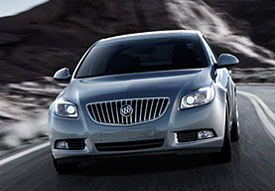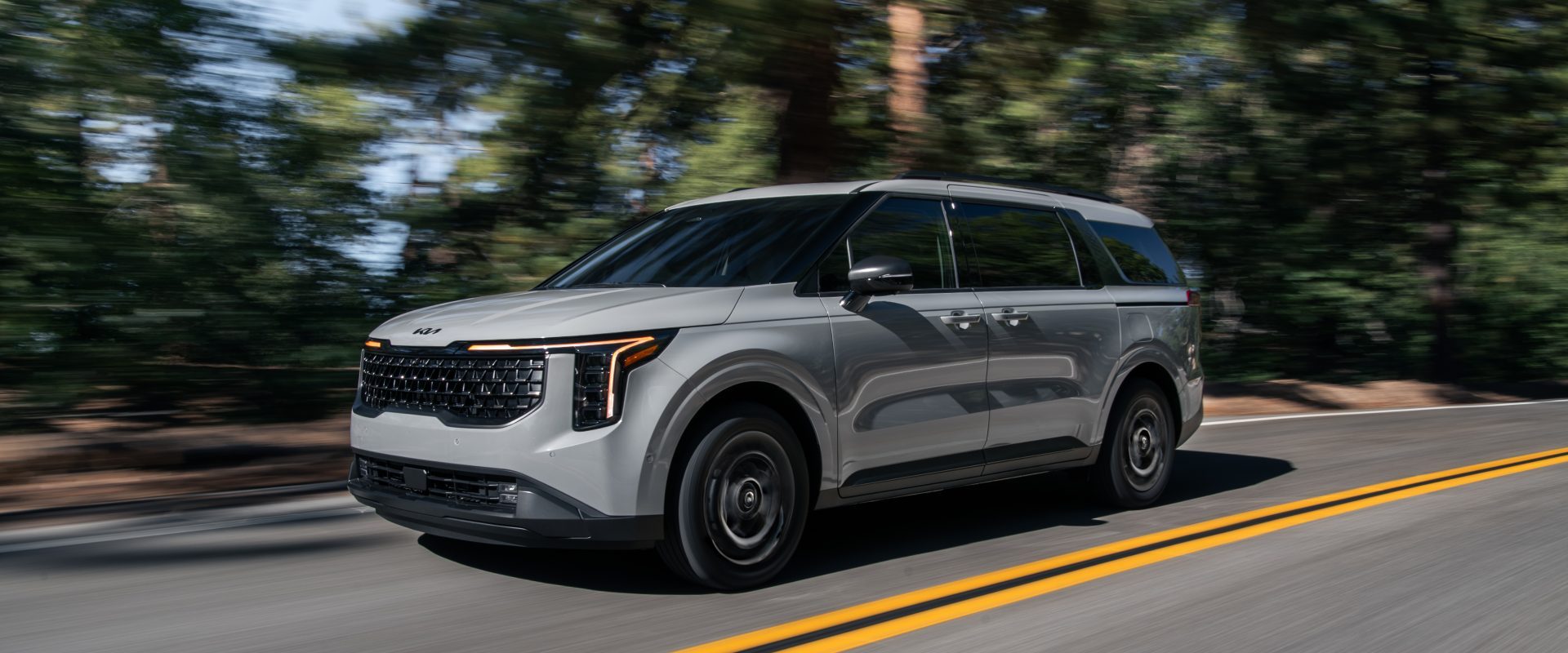2011 Buick Regal
While most buyers think of Buick as a posh, premium brand, their performance car history actually dates back to the legendary straight-8s of the 1930s. In more recent decades, the Regal nameplate carried the best of Buick’s performance intensions. So it makes sense that when Buick planned an all-new, mid-size sports sedan that the Regal name would once again appear. But this Regal is not like any Buick we’ve driven before.
After a six-year absence, the Buick Regal returns for 2011 as an all-new Euro-bred, front-drive sports sedan. Developed at Germany’s famed Nurburgring, the new Regal is a near doppelganger to the Opel Insignia – Europe’s 2009 Car of the Year, and the most promising entry from GM’s tri-shield division since the Grand Nationals of the 1980’s. To that end, the Regal will compete with premium-level sports sedan like the Audi A4, Acura TSX, Volkswagen CC, and Volvo’s new S60.
Initially imported in premium CXL trim only, the Regal touts the same sleek and upscale design language, but adds a healthy dose of frontal aggression from the LaCrosse and Enclave - an oversized Buick waterfall grille, flanked by prominent, swept-back, non-HID headlamps.
 The Regal’s sculpted coupe-like profile features a fast, flowing roofline, sharp body creases, and flared fenders, exuding a performance-oriented spirit. The tapered rear wears an abbreviated deck and bold tail lamps, both hallmarks of the contemporary sports sedan. Standard alloy wheels are 18-inch, with 19s optional.
The Regal’s sculpted coupe-like profile features a fast, flowing roofline, sharp body creases, and flared fenders, exuding a performance-oriented spirit. The tapered rear wears an abbreviated deck and bold tail lamps, both hallmarks of the contemporary sports sedan. Standard alloy wheels are 18-inch, with 19s optional.
Power will be a surprise to some, four cylinder direct-injected powertrains only from GM’s Ecotec family. The standard 2.4-liter, shared with the Lacrosse and Chevy Equinox, delivers 182 horsepower and 172 pound-feet of torque.
Optional is a 2.0-liter twin-scroll turbo with 220 horsepower and 258 pound-feet of torque. An even higher-performance turbo GS arrives next year. The 2.4 is mated to a self-shift six-speed automatic, while the 2.0 turbo offers a proper six-speed manual as standard and automatic as option. Unfortunately, for our test runs only a 2.4 automatic was available.
And while it felt pretty peppy off the line, it was only adequate overall; taking a longish 9.4 seconds to get to 60, and 17 seconds to complete the quarter mile at 84 miles per hour. We’d definitely opt for the 2.0 turbo. But, it is taking corners where this Regal shines brightest. The Epsilon II chassis, with its strut-type front, and four-link rear suspension, both with a hollow stabilizer bar, delivered an impressive level of agility and nimbleness.
Turbo models add a fine Interactive Drive Control System. Its three modes - Standard, Tour, or Sport - alter suspension settings, steering sensitivity, throttle response, and shift pattern. Stopping hardware is all disc ABS brakes. Our car met hard stops with a 60 to 0 average of 129 feet, all straight and smooth.
This Regal meets all the European sports sedan cliches. It handles like it’s on rails. It feels bolted to the road. But you’ve got to remember, this is a Buick and it’s made in Germany, and that puts this Regal in a whole new light. The Regal’s spacious and well-appointed cabin combines classic Buick styling with modern sports sedan cues.
 Fit and finish are on par with anything in the premium segment, although the dash is mostly hard plastics. On the other hand, gauges and controls exude a decidedly upscale quality.
Fit and finish are on par with anything in the premium segment, although the dash is mostly hard plastics. On the other hand, gauges and controls exude a decidedly upscale quality.
Seats are well-positioned, firm, and nicely-bolstered. Leather upholstery and seat heat come standard. Enhancing occupant comfort is standard auto climate with humidity sensor. For piping in your favorite driving music, there’s a seven-speaker stereo or an upgraded nine-speaker Harman Kardon audio system.
But oh-so European is the absence of an available rear view camera. As is the console mounted, multi-function central controller for Stereo, Nav, Bluetooth, and even OnStar. The rear seat is comfortable for two adults, but tight for three. And the 60/40 split-folding feature adds length to the already very usable 14.3 cubic foot trunk.
Government Fuel Economy Ratings for the Regal 2.4 are 19 city/30 highway. We achieved a fine 27.1 on regular in real-world driving. The Energy Impact Score is 14.9 barrels of oil consumed per year. The Carbon Footprint is a relatively modest 8.1 annual tons of CO2 emitted.
Pricewise, the new Regal is very competitive. The 2.4 CXL has a base sticker of $26,995. The CXL Turbo starts at $29,495. More models and a lower entry price will follow when Regal production moves to the U.S. next year.
Despite its stodgy name, the 2011 Buick Regal made a great impression on us. Yes, it needs the 2.0 turbo manual to be truly competitive to its European rivals. But even the standard car we tested was a revelation. We just hope the Regal is not a one-off effort, and that Buick performance is back for real.
Specifications
- Engine: 2.4-Liter
- Horsepower: 182
- Torque: 172 Lb Feet
- 0-60 MPH: 9.4 Seconds
- 1/4 Mile: 17.0 Seconds @ 84 MPH
- 60-0 MPH: 129 Feet
- EPA: 19 MPG City/ 30 MPG Highway
- Mixed Loop: 27.1 MPG
- Energy Impact 14.9 Barrels Oil/Yr:
- CO2 Emissions: 8.1 Tons/Yr
2025 Kia Carnival Hybrid
Kia Adds Hybrid Assistance To Keep The Party Going
For 2022, Kia gave their minivan a major reboot. So much so, they changed the name to Carnival and even stopped calling it a minivan. Well, they can’t fool us though. After all, we love minivans for their all-around practicality. Well for 2025, Kia has updated its multi-purpose people mover, including adding hybrid power. So, let’s see if that makes time in the new Carnival even more festive.
With many brands no longer even competing in the minivan segment, it’s noteworthy that not only is Kia still in the game, they’ve given their multi-purpose 2025 Carnival a major update after only 3 years on the market. That update includes a first-time optional hybrid powertrain.
The Carnival Hybrid config is an extension of the Sorento SUV’s setup, pairing a 1.6-liter turbo-four engine with a larger 54-kW electric motor. Combined output of 242 horsepower, 15 more than Sorento. Total torque is a stout 271 lb-ft, getting to the front wheels through a true six-speed automatic transmission. Throw in a full 19-gallon fuel tank and you’ve got close to 600 miles of range, allowing you to keep the party going farther than before.
The V6 Carnival remains available, although it’s now listed at 287 horsepower, down from 290. But the Government Fuel Economy Ratings take a huge leap here in the Hybrid; from 18 City, 26 Highway, 21 Combined to 34 City, 31 Highway, and 33 Combined.
The Hybrid comes with a few additional tricks up its sleeve, the most noticeable being the dial-like shifter in the console. But there is also a pretty clever regen braking setup that Kia calls E-VMC. The Electrification-Vehicle Motion Control has three levels of regen, but also has an E-Handling component which adjusts regen going into corners and amounts of electric assist when coming out of them; E-Ride, which includes unique shock tuning for the Hybrid but also can engage the electric motors to mitigate harsh impacts; and E-Evasive Handling Assist, which kicks in during emergency maneuvers. All techy cool!
Another step in Kia’s efforts of making everyone forget this MPV is actually a minivan.
All Carnivals regardless of powertrain get updated styling for ’25 which includes a new face that trades the concave grille for a flatter, larger one. The headlights are no longer incorporated into the grille, and the daytime running lights are much snazzier. In back, the taillights take on a completely different look, with much larger vertical elements on the sides. The liftgate gets a chunkier SUV-like vibe and the rear bumper is more pronounced than before. Altogether, another step in Kia’s efforts of making everyone forget this MPV is actually a minivan.
There’s upgraded tech for the inside, namely Kia’s new frameless panoramic display that incorporates both the 12.3-inch driver display and 12.3-inch touchscreen infotainment. It not only looks better, but processing speeds are much faster. The driver’s display gets a completely new theme with modern bar and number style speed displays instead of virtual gauges. A Full Display Mirror is also now available, which can switch from traditional mirror to camera.
The Hybrid has a bit less horsepower but 10 additional lb-ft of torque, so off to Mason Dixon Dragway for some numbers. It certainly didn’t feel underpowered, spinning up the tires off the line and even chirping on the shift into second. We hit 60 in a respectable 8.0 seconds, which is still .80 slower than the V6. Our best quarter-mile time was 16.2 seconds at 88 mph.
There was a different vibe to the handling experience, as E-Handling virtually eliminated understeer. But there was still some body roll and stability systems were eager to engage quickly. The brakes retain a natural feel, and stopping distances averaged a good 110 feet from 60.
The Carnival Hybrid is available in four of the Carnival’s five trims, all but the base LX. So, a base LXS Hybrid goes for $42,235, a $2,000 premium over the V6.
The 2025 Kia Carnival Hybrid offers more than just much better fuel economy. Kia has found a way to integrate battery assistance into just about every mechanical aspect of the vehicle, delivering a driving experience that is unique from its V6 counterpart, and adding more good vibes to an already exceptional family vehicle.
Specifications
As Tested
- Engine: 1.6-liter turbo-4
- Transmission: 6-speed automatic
- Horsepower: 242
- Torque: 271 lb-ft
- 0-60 mph: 8.0 seconds
- 1/4 Mile: 16.2 seconds at 88 mph
- Braking, 60-0 (avg.): 110 feet
- EPA: 34 City | 31 Highway | 33 Combined







